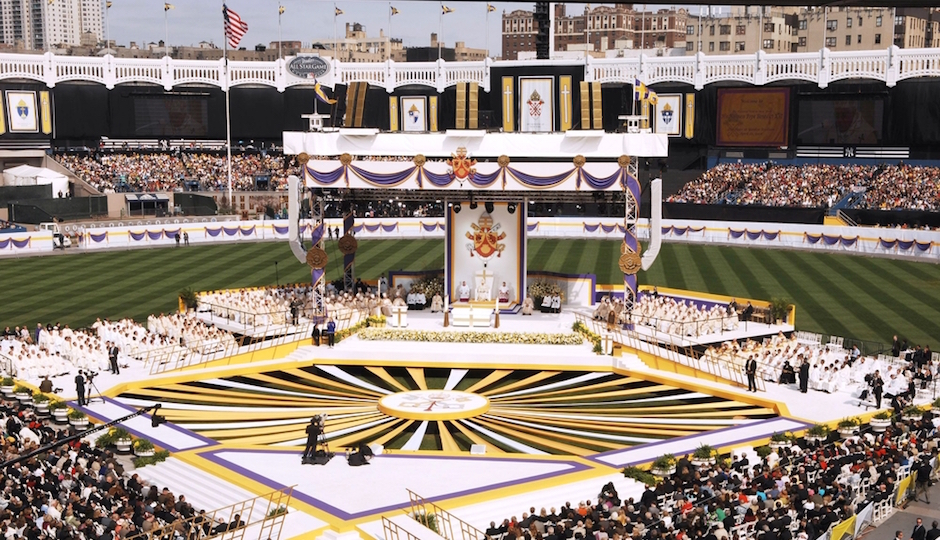Why Pope Francis’ Visit Might Be Philly’s Biggest Challenge Ever

Pope Benedict celebrated Mass at Yankee Stadium in 2008. He did it the easy way.| Everett Collection / Shutterstock.com
This week, it seems, Philly reached a tipping point.
We’ve known for a while now that Pope Francis will visit in September, that it’ll bring a lot of people to town, and that it’s going to make everything just a bit crazy. This week, though, is when it all seemed like it might be too much — like a backlash might be settling in.
It might’ve been talk of a perimeter fence. It might’ve been the proposal to shut down the Ben Franklin Bridge. Perhaps it was the notion of shutting down I-95. Whatever the trigger point, it’s all starting to seem a bit much.
The question is why?
Other cities have hosted the pope. Other cities have hosted the World Meeting of Families. And other cities have put on big events in a post-9/11 security environment. So why does it seem like we’re the ones being overwhelmed by the task?
Here’s the answer: What we’re doing is unprecedented.
Other cities have hosted the pope. But they’ve not invited the whole world into the heart of their city while trying to maintain War on Terror standards of security at the same time. Nobody has attempted this scale at this degree of difficulty. So maybe we need to give ourselves a collective break.
To get a sense, compare what’s happening in Philly to three other papal trips: Pope Benedict to New York in 2008, Pope John Paul II to Denver in 1993 and Pope Benedict to Milan in 2012.
• NEW YORK 2008: In some ways, the comparison is unfair. New York is one of the capitals of the world. The U.N. General Assembly brings world leaders every year. So handling major security events is simply part of the routine — a luxury-slash-annoyance we don’t have in Philadelphia.
But New York had one other advantage: Scarcity.
Pope Benedict celebrated Mass at Yankee Stadium, after all. Which meant that only 50,000-60,000 people were ever going to get to experience that directly. The result? Not as many people tried: Some reports at the time suggested as many as 200,000 people had sought tickets to the event.
That’s a lot. But Pope Francis will be celebrating Mass on the Parkway. There are no seating limits. Until they get here, people won’t know if they’re within a rosary’s throw of the pontiff or stuck watching him on a Jumbotron way out in the (relative) boonies. Since they can’t be denied tickets that don’t exist, they’ll come with hope in their hearts — at least a million of them, by the most conservative estimates, and maybe as many as 2 million. New York would be overwhelmed by that many additional short-term visitors, but it never had to worry about it with Benedict.
• DENVER 1993: OK, but you can’t always hold Mass in a baseball stadium. Denver hosted the pope for World Youth Day — like the World Meeting of Families, one of the largest worldwide gatherings of Catholics — and demand was so great, the final Mass was moved to a state park, where an estimated 750,000 celebrants showed up.
That was a lot — more than Denver organizers expected initially, in fact. But still manageable. Why? Well, Denver offers a different kind of scarcity than Yankee Stadium: It’s remote. The closest city big enough for a major sports team is Salt Lake City, just more than 500 miles away. So if you’re driving into Denver on a lark, chances are it’s a really long drive. That can discourage just enough people to make a gathering in Denver huge but not too huge.
Philadelphia? We’re smack dab in the middle of the Northeast Corridor — Boston, New York, Baltimore, Richmond, Pittsburgh and Washington D.C. are all major cities within 360 miles of here, so there’s a much bigger population of people nearby who might want to see the pope. And the Corridor’s got the nation’s most robust transportation system: Buses, train, planes and roads all might bring you here from those locations with relative efficiency.
So: We’re making it really easy for people to think they might see the pope if they show up. And we’re doing it in an already-crowded region. The degree of difficulty keeps getting steeper.
• MILAN 2012: A million people attended this one — another World Meeting of Families event, the last with Pope Benedict. Fifteen thousand extra cops were deployed. So a big Mass. And lots of security.
How’d Milan keep it manageable? By holding the shindig at an airfield outside the city. As with Denver, where mass was held at the state park, existing neighborhoods weren’t disrupted the way Center City — a residential district and Philly’s prime business district — will be by the visit of Pope Francis.
And that’s one other difference: Every pope is a rock star. Francis, we’ve seen, might be on another level.
Like I said: What we’re doing in Philadelphia is nearly unprecedented. We’re inviting an unusually popular pope to celebrate an open-air mass in the middle of a crowded city district in one of the most populated urban regions in the world. That’s difficult, difficult stuff.
Maybe too difficult? Perhaps the Mass should’ve been held at the Linc. Or in Fairmount Park. But it’s likely too late to think about those changes now. We’ve set ourselves an incredible challenge, Philly. The best thing we can do is try to meet it as best we can.
Follow @JoelMMathis on Twitter.


